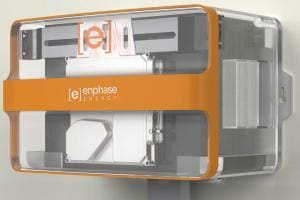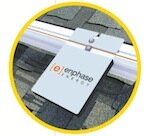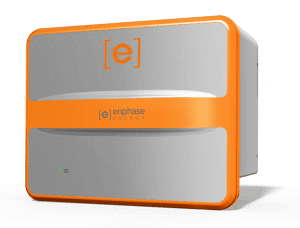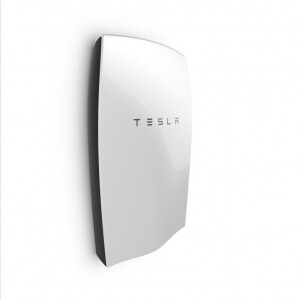Solar Choice: Enphase is known mainly for its world-leading microinverters. What spurred the company to get involved in the energy storage market, and why did it choose Australia as the launching ground for its AC Battery?
Raghu Belur: If you notice, we are not called ‘Enphase Solar’ – we are called ‘Enphase Energy’. When industries mature they expect to get solutions, not products. I’m old enough to remember buying parts for my PC. These days, you buy an iPhone or iPad and you connect. This notion of components doesn’t exist anymore. Our belief is that end-users are looking for solutions – not solar or storage alone, necessarily. Solar as a starting point made sense, but the next stage is energy management and energy solutions.
To our customers – our installer partners – this easy to design, install and maintain plug-and-play solution that allows them to provide higher value offerings to their customers – households. These end customers save money at the end of the day. Solar is just the starting point – eventually our customers will want energy systems.
Enphase, to meet this goal, has developed an entire operating system – and I guess you could say solar is the first application in that operating system. Solar, storage, load management, all managed through an energy management system – these are the next applications.
 From our very inception, we always said we would never design a simple microinverter – we’d design a microinverter system as a complete platform. It’s therefore a natural extension for a company like Enphase to move into storage and load management.
From our very inception, we always said we would never design a simple microinverter – we’d design a microinverter system as a complete platform. It’s therefore a natural extension for a company like Enphase to move into storage and load management.
A major breakthrough happened with Gen 5 of our products: we took a device that is this microinverter (which takes DC electricity and turns it into AC) and turned it into an ideal converter, which means it can still perform that function but it can also go from AC to DC. So the same device that goes onto the roof goes into the AC battery as well. All of that is managed with the same software that is used for solar. So it made the right business sense to move into the energy storage segment, and we got a tremendous amount of technology leverage because we invented all of these things for solar.
SC: So it’s almost like how all the cells in the body have the same DNA but eventually go on to become different organs – except on a much smaller scale of course.
 RB: I love the analogy and if you’re okay with it, I’ll quote you and use it. Plus the communications are the same – they communicate exactly the same way. The back-end software, the cloud infrastructure is identical.
RB: I love the analogy and if you’re okay with it, I’ll quote you and use it. Plus the communications are the same – they communicate exactly the same way. The back-end software, the cloud infrastructure is identical.
SC: Run with it.
RB: But that’s exactly what it is because the power converter that goes in the AC battery is the same device that goes on the roof for solar. The only thing different is the software.
SC: So why Australia as the launching ground?
RB: If you think about it by the market drivers for storage, if you look at mature solar markets where there’s high penetration of PV plus you’re seeing this inversion between the cost of retail electricity and your feed-in tariffs – any rational person would conclude that it make no economic sense to push a single electron across the meter. That, coupled with the fact that your solar profile (which peaks in the middle of the day) doesn’t match your load profile (which peaks in the mornings and late afternoon).
The combination of the misalignment of peaks plus policy (disappearing tariffs) results in a natural evolution. In order for solar to be really effective you need storage as well. Plus the social/cultural aspect as well – Australians like to embrace new technologies and try new things out.
But Australia is also a leading indicator of the way the world is going, actually. You see the same happening in Europe and in the US as net metering is under pressure. So this is why Enphase has such a big team in Australia. We actually do a lot of our product development here and in New Zealand. We’re very bullish about where things are headed in this region as they move toward the adoption of solar and energy storage in general.
SC: What makes Enphase’s energy storage solution unique in the market? Which products will it be competing with?
RB: Well one thing that is unique about the Australian market (vs for example the US market) is that it’s going to start out as a retrofit market. There are about 160,000 systems installed just in NSW who are likely to want storage when the state’s feed-in tariff expires.
Our solution is perfect for the retrofit. Our architecture is abstracted away from solar. You can have solar only, you can have storage only – and you can even have a mix and match of Enphase and other products in a single system. Enphase’s batteries can be connected to any system that is out there. That’s a pretty big differentiator from a lot of the other products out there.
SC: Including the Powerwall.
 RB: Yes – Tesla is a great company and we have a tremendous amount of respect for them, but they make only the widget – the battery. It’s not a ‘solution’. They have the battery and the battery management system (BMS). What we have is the battery, the BMS, the charge controller, the inverter, all the software and the communications. Our solution is complete. For them, you have to take the Powerwall and attach all the interconnection components, an inverter – and you may even have to ‘forklift upgrade’ your existing inverter, meaning that you’ll have to pull the existing inverter out and put a new inverter in its place. That’s pretty comprehensive.
RB: Yes – Tesla is a great company and we have a tremendous amount of respect for them, but they make only the widget – the battery. It’s not a ‘solution’. They have the battery and the battery management system (BMS). What we have is the battery, the BMS, the charge controller, the inverter, all the software and the communications. Our solution is complete. For them, you have to take the Powerwall and attach all the interconnection components, an inverter – and you may even have to ‘forklift upgrade’ your existing inverter, meaning that you’ll have to pull the existing inverter out and put a new inverter in its place. That’s pretty comprehensive.
 Plus you can look at it from a labour perspective. Our device weighs about 23kg: It’s a one-person install that you can hang on the wall. With other devices it can weigh anywhere from 40 kilos to 400 kilos. In some instances (not for the Powerwall) you may even have to pour a concrete pad. It’s unfortunate but a lot of people compare the Powerwall to us, but the Powerwall is just one element of their storage solution. Ours is completely integrated into one device.
Plus you can look at it from a labour perspective. Our device weighs about 23kg: It’s a one-person install that you can hang on the wall. With other devices it can weigh anywhere from 40 kilos to 400 kilos. In some instances (not for the Powerwall) you may even have to pour a concrete pad. It’s unfortunate but a lot of people compare the Powerwall to us, but the Powerwall is just one element of their storage solution. Ours is completely integrated into one device.
In fact, Tesla is not our only competitor – we have many competitors. And I look at that as a good thing for the industry. The industry and consumers alike benefit from the competition. It’s also an indication of what people see – there are a bunch of companies out there who can see that it makes sense to do this in a place like Australia. So economics get better and better over time as volumes increase and supply chain efficiencies roll in. But the fact that there are so many people talking about it means that there is something here.
SC: Where does the AC Battery sit on the cost spectrum? Any other thoughts or comments on energy storage system prices?
RB: We always have to think about four things when it comes to cost for storage:
- Battery chemistry (lithium, lead, etc),
- Power management (you need the battery to charge and discharge),
- Installation cost (which will very a lot on things like weight), and
- Integration cost (the system needs a system to decide when to charge and dispatch batteries).
Let’s look at these costs one by one:
Chemistry cost is going to be driven by the electric vehicle (EV) business, not by stationary storage. While we absolutely love our battery partner (who we chose with care), we are also chemistry agnostic. All we have to do is swap out the module, change the software a little bit and you have an AC battery with a different chemistry. Right now our battery is lithium-iron phosphate from a Japanese vendor but if tomorrow there is a new, better chemistry that comes along and it’s half the cost and twice the efficiency, we can embrace that. We ride the commoditisation curve for chemistry. that’s the beauty of our architecture.
The second thing is power management. This is about leveraging economy of scale. As I mentioned before, our power management system uses the exact same inverter that’s on the roof. We make 10 to 12 thousand of those a day. There’s not a different inverter that we have to invent for this.
Third, installation – this is a huge deal that you have a 23 kilo system that’s a one-person install that literally plugs into your AC interconnection. So we drive the cost of the installation down quite a bit.
And the fourth part is integration. Just by plugging the AC battery in, our software detects it and says ‘oh, I just got pinged by an AC battery’ and you can start running whatever heuristics you want to run; the basic one being, say, zero export.
So my point is, looking at it just from a cost-per-unit standpoint, we will always have a cost advantage. Price: people will price where they want. That’s a business decision. But if you look at it from a fundamentals standpoint, our system will be the most cost-efficient.
 Now there’s another cost that’s starting to come into play a lot. Because our battery system is made up of 1.2kWh building blocks, as opposed to other solutions that are fixed with very big sized storage, we can ‘right-size’ our storage solution and tailor it to individual homes. Storage is not one-size-fits-all: your storage needs may be very different from your neighbour’s storage needs. You may need four AC batteries and your neighbour may only need 3. With other solutions there is what we call a quantitisation problem: they come in 7 or 10kWh chunks. Obviously there’s a big cost associated with that. Let’s say you only need 4kWh but the smallest unit available is a 7kWh battery bank. So there’s a right-sizing cost advantage for us as well.
Now there’s another cost that’s starting to come into play a lot. Because our battery system is made up of 1.2kWh building blocks, as opposed to other solutions that are fixed with very big sized storage, we can ‘right-size’ our storage solution and tailor it to individual homes. Storage is not one-size-fits-all: your storage needs may be very different from your neighbour’s storage needs. You may need four AC batteries and your neighbour may only need 3. With other solutions there is what we call a quantitisation problem: they come in 7 or 10kWh chunks. Obviously there’s a big cost associated with that. Let’s say you only need 4kWh but the smallest unit available is a 7kWh battery bank. So there’s a right-sizing cost advantage for us as well.
Part 1: The evolving role of the solar home on the electricity grid
Part 2: Home solar in Australia: To grid or not to grid?
Part 3: Why Australia is fertile ground for home battery storage
© 2015 Solar Choice Pty Ltd
- Solar Power Wagga Wagga, NSW – Compare outputs, returns and installers - 13 March, 2025
- Monocrystalline vs Polycrystalline Solar Panels: Busting Myths - 11 November, 2024
- Solar Hot Water System: Everything You Need to Know - 27 February, 2024
I already have the enphase solar system on my roof – 2.5kw.How may batteries would I need to power the 2 fridge/freezers ,a few lights, the odd microwave use plus the household pump for washing and toilet use during the night?
Should the grid go down is there a by-pass system in place to divert battery power to keep lights and household pump active for toilet flushing purposes? Or does one still need to pull out the diesel generator?
I look forward to your answers.
Regards, Hank de Vries Q’ld
Hi Hank,
I’ve reached out to Enphase directly with your question. Their response is below:
If you’re considering batteries, then you could add them to your existing system just to increase your self consumption, using more of the power you’re creating, and exporting less to the grid, or you could try, and you could also consider adding more solar and batteries to become even less reliant on the grid.
The easiest way to design a battery system based on how much storage you need is by using a data logger like the new Envoy-S Metered. This way you can measure your consumption and generation, to show us how much you’re using through the day and night. The Envoy-S Metered is the newer Envoy that also controls how our AC Batteries work, letting them know when to charge from your excess power, and when to discharge because you’re using more power than what the solar is generating. With this data, we can make some recommendations based on your power usage and your existing Enphase system.
If you’d prefer to design your battery system to maximise self consumption, not adding any more solar at present, then I’d start by looking at how many kWh per day you are currently exporting to the grid, and thinking about capturing this energy to utilise later into the afternoon/evening. So if your 2.5kW Enphase system is currently generating an average of 8 to 12kWh per day, and you’re exporting an average of 4kWh per day (hopefully a few of your recent power bills will help you work out how many kWh per day you’re selling back to the grid) then I’d recommend you look at 3 or 4 of our AC Batteries, giving you 3.6 to 4.8kWh of storage, which you can expand in the future if you would like more, or if you expand your PV system as well.
We are not yet ready for our batteries to run without the grid, so if you’re experiencing a lot of blackouts, your existing diesel generator and a transfer switch might be ideal as an low cost solution.
Nice Topic